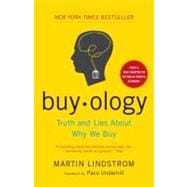How much do we know about why we buy? What truly influences our decisions in today's message-cluttered world? An eye-grabbing advertisement, a catchy slogan, an infectious jingle? Or do our buying decisions take place below the surface, so deep within our subconscious minds, we're barely aware of them?
In BUYOLOGY, Lindstrom, who was voted one of Time Magazine's most influential people of 2009, presents the astonishing findings from his groundbreaking, three-year, seven-million-dollar neuromarketing study, a cutting-edge experiment that peered inside the brains of 2,000 volunteers from all around the world as they encountered various ads, logos, commercials, brands, and products. His startling results shatter much of what we have long believed about what seduces our interest and drives us to buy. Among the questions he explores:
Does sex actually sell? To what extent do people in skimpy clothing and suggestive poses persuade us to buy products?
Despite government bans, does subliminal advertising still surround us – from bars to highway billboards to supermarket shelves?
Can "Cool" brands, like iPods, trigger our mating instincts?
Can other senses – smell, touch, and sound - be so powerful as to physically arouse us when we see a product?
Do companies copy from the world of religion and create rituals – like drinking a Corona with a lime – to capture our hard-earned dollars?
Filled with entertaining inside stories about how we respond to such well-known brands as Marlboro, Nokia, Calvin Klein, Ford, and American Idol, BUYOLOGY is a fascinating and shocking journey into the mind of today's consumer that will captivate anyone who's been seduced – or turned off – by marketers' relentless attempts to win our loyalty, our money, and our minds.
“Move over Tipping Point and Made to Stick because there’s a new book in town: Buyology. This book lights the way for smart marketers and entrepreneurs.”-Guy Kawasaki, Author of The Art of the Start
"Martin Lindstrom is one of branding's most original thinkers"-Robert A. Eckert, CEO & Chairman, Mattel, Inc.
“Lindstrom takes us on a fascinating journey inside the consumer brain. Why do we make the decisions we do? Surprising and eye opening, Buyology is a must for anyone conducting a marketing campaign.”-Ori Brafman, author of the bestselling book, Sway








